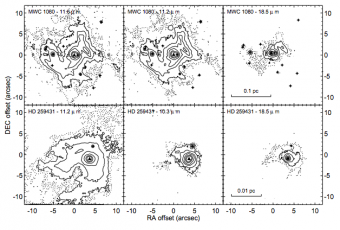 Deep mid-infrared (10-20 $\mu$m) images with sub-arcsec resolution were obtained for two Herbig Be stars, MWC 1080 and HD 259431, to probe their immediate environments. Our goal is to understand the origin of the diffuse nebulosities observed around these two very young objects. By analyzing our new mid-IR images and comparing them to published data at other wavelengths, we demonstrate that the well extended emission around MWC 1080 traces neither a disk nor an envelope, but rather the surfaces of a cavity created by the outflow from MWC 1080A, the primary star of the MWC 1080 system. In the N-band images, the filamentary nebulosities trace the hourglass-shaped gas cavity wall out to $\sim$0.15 pc. This scenario reconciles the properties of the MWC 1080 system revealed by a wide range of observations. Our finding confirms that the environment around MWC 1080, where a small cluster is forming, is strongly affected by the outflow from the central Herbig Be star. Similarities observed between the two subjects of this study suggest that the filamentary emission around HD 259431 may arise from a similar outflow cavity structure, too.
Deep mid-infrared (10-20 $\mu$m) images with sub-arcsec resolution were obtained for two Herbig Be stars, MWC 1080 and HD 259431, to probe their immediate environments. Our goal is to understand the origin of the diffuse nebulosities observed around these two very young objects. By analyzing our new mid-IR images and comparing them to published data at other wavelengths, we demonstrate that the well extended emission around MWC 1080 traces neither a disk nor an envelope, but rather the surfaces of a cavity created by the outflow from MWC 1080A, the primary star of the MWC 1080 system. In the N-band images, the filamentary nebulosities trace the hourglass-shaped gas cavity wall out to $\sim$0.15 pc. This scenario reconciles the properties of the MWC 1080 system revealed by a wide range of observations. Our finding confirms that the environment around MWC 1080, where a small cluster is forming, is strongly affected by the outflow from the central Herbig Be star. Similarities observed between the two subjects of this study suggest that the filamentary emission around HD 259431 may arise from a similar outflow cavity structure, too.
Authors: Dan Li, Naibí Mariñas, Charles M. Telesco

